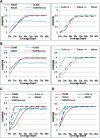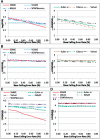Comparative studies of de novo assembly tools for next-generation sequencing technologies
- PMID: 21636596
- PMCID: PMC3137213
- DOI: 10.1093/bioinformatics/btr319
Comparative studies of de novo assembly tools for next-generation sequencing technologies
Abstract
Motivation: Several new de novo assembly tools have been developed recently to assemble short sequencing reads generated by next-generation sequencing platforms. However, the performance of these tools under various conditions has not been fully investigated, and sufficient information is not currently available for informed decisions to be made regarding the tool that would be most likely to produce the best performance under a specific set of conditions.
Results: We studied and compared the performance of commonly used de novo assembly tools specifically designed for next-generation sequencing data, including SSAKE, VCAKE, Euler-sr, Edena, Velvet, ABySS and SOAPdenovo. Tools were compared using several performance criteria, including N50 length, sequence coverage and assembly accuracy. Various properties of read data, including single-end/paired-end, sequence GC content, depth of coverage and base calling error rates, were investigated for their effects on the performance of different assembly tools. We also compared the computation time and memory usage of these seven tools. Based on the results of our comparison, the relative performance of individual tools are summarized and tentative guidelines for optimal selection of different assembly tools, under different conditions, are provided.
Figures


Similar articles
-
Benchmarking of de novo assembly algorithms for Nanopore data reveals optimal performance of OLC approaches.BMC Genomics. 2016 Aug 22;17 Suppl 7(Suppl 7):507. doi: 10.1186/s12864-016-2895-8. BMC Genomics. 2016. PMID: 27556636 Free PMC article.
-
Assembly algorithms for next-generation sequencing data.Genomics. 2010 Jun;95(6):315-27. doi: 10.1016/j.ygeno.2010.03.001. Epub 2010 Mar 6. Genomics. 2010. PMID: 20211242 Free PMC article. Review.
-
A pilot study for channel catfish whole genome sequencing and de novo assembly.BMC Genomics. 2011 Dec 22;12:629. doi: 10.1186/1471-2164-12-629. BMC Genomics. 2011. PMID: 22192763 Free PMC article.
-
De novo assembly of the Pseudomonas syringae pv. syringae B728a genome using Illumina/Solexa short sequence reads.FEMS Microbiol Lett. 2009 Feb;291(1):103-11. doi: 10.1111/j.1574-6968.2008.01441.x. Epub 2008 Dec 9. FEMS Microbiol Lett. 2009. PMID: 19077061
-
De novo assembly of short sequence reads.Brief Bioinform. 2010 Sep;11(5):457-72. doi: 10.1093/bib/bbq020. Epub 2010 Aug 19. Brief Bioinform. 2010. PMID: 20724458 Review.
Cited by
-
Evaluating de Bruijn graph assemblers on 454 transcriptomic data.PLoS One. 2012;7(12):e51188. doi: 10.1371/journal.pone.0051188. Epub 2012 Dec 7. PLoS One. 2012. PMID: 23236450 Free PMC article.
-
Construction of Whole Genomes from Scaffolds Using Single Cell Strand-Seq Data.Int J Mol Sci. 2021 Mar 31;22(7):3617. doi: 10.3390/ijms22073617. Int J Mol Sci. 2021. PMID: 33807210 Free PMC article.
-
CGAL: computing genome assembly likelihoods.Genome Biol. 2013 Jan 29;14(1):R8. doi: 10.1186/gb-2013-14-1-r8. Genome Biol. 2013. PMID: 23360652 Free PMC article.
-
Fitness Tradeoffs of Antibiotic Resistance in Extraintestinal Pathogenic Escherichia coli.Genome Biol Evol. 2018 Feb 1;10(2):667-679. doi: 10.1093/gbe/evy030. Genome Biol Evol. 2018. PMID: 29432584 Free PMC article.
-
Reference-independent comparative metagenomics using cross-assembly: crAss.Bioinformatics. 2012 Dec 15;28(24):3225-31. doi: 10.1093/bioinformatics/bts613. Epub 2012 Oct 16. Bioinformatics. 2012. PMID: 23074261 Free PMC article.
References
Publication types
MeSH terms
Grants and funding
LinkOut - more resources
Full Text Sources
Other Literature Sources
Research Materials
Miscellaneous

